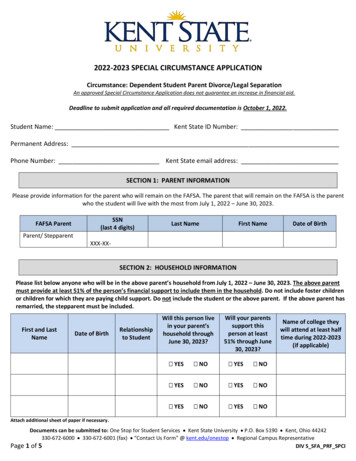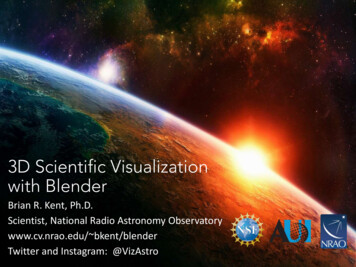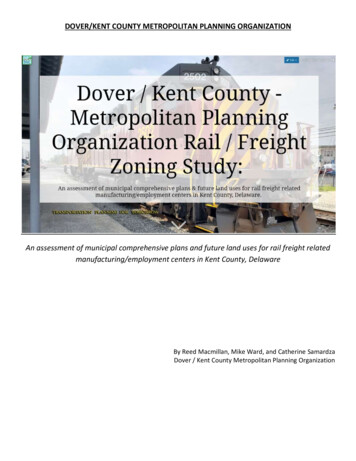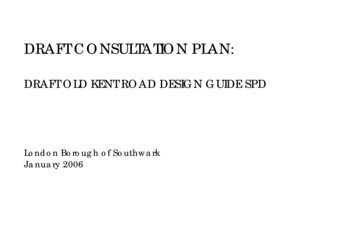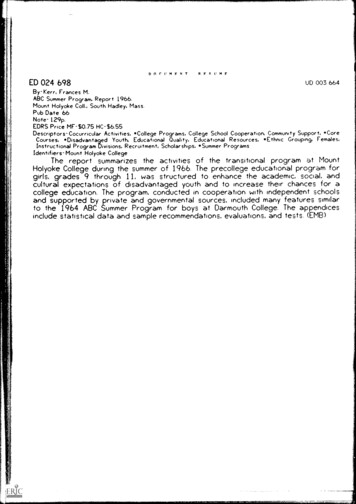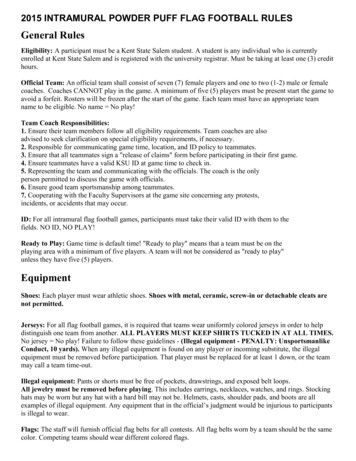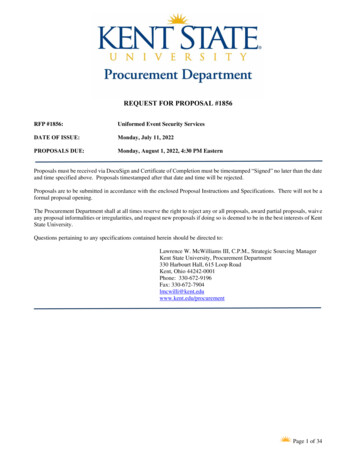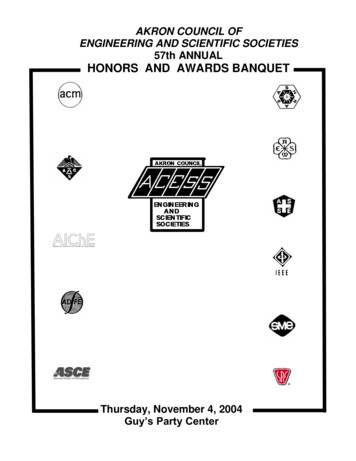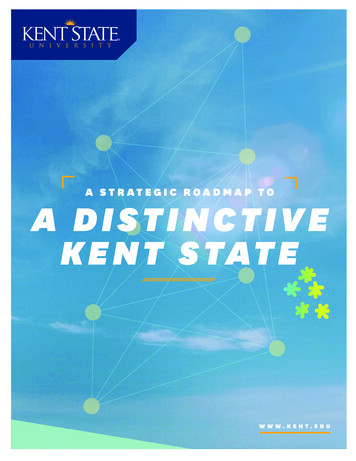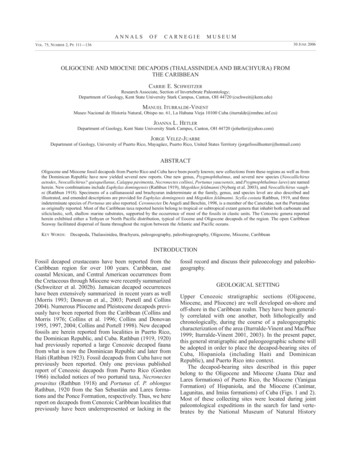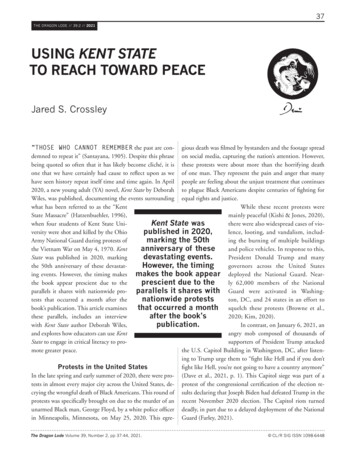
Transcription
37THE DRAGON LODE // 39:2 // 2021USING KENT STATETO REACH TOWARD PEACEJared S. Crossley“THOSE WHO CANNOT REMEMBER the past are con- gious death was filmed by bystanders and the footage spreaddemned to repeat it” (Santayana, 1905). Despite this phrase on social media, capturing the nation’s attention. However,being quoted so often that it has likely become cliché, it is these protests were about more than the horrifying deathone that we have certainly had cause to reflect upon as we of one man. They represent the pain and anger that manyhave seen history repeat itself time and time again. In April people are feeling about the unjust treatment that continues2020, a new young adult (YA) novel, Kent State by Deborah to plague Black Americans despite centuries of fighting forWiles, was published, documenting the events surrounding equal rights and justice.what has been referred to as the “KentWhile these recent protests wereState Massacre” (Hatzenbuehler, 1996),mainly peaceful (Kishi & Jones, 2020),when four students of Kent State UniKent State wasthere were also widespread cases of vioversity were shot and killed by the Ohiopublished in 2020,lence, looting, and vandalism, includArmy National Guard during protests ofmarking the 50thing the burning of multiple buildingsthe Vietnam War on May 4, 1970. Kentanniversary of theseand police vehicles. In response to this,State was published in 2020, markingdevastating events.President Donald Trump and manythe 50th anniversary of these devastatHowever, the timinggovernors across the United Statesing events. However, the timing makes makes the book appear deployed the National Guard. Nearthe book appear prescient due to theprescient due to thely 62,000 members of the Nationalparallels it shares with nationwide pro- parallels it shares with Guard were activated in Washingtests that occurred a month after thenationwide protestston, DC, and 24 states in an effort tobook’s publication. This article examinesthat occurred a month squelch these protests (Browne et al.,these parallels, includes an interviewafter the book’s2020; Kim, 2020).with Kent State author Deborah Wiles,publication.In contrast, on January 6, 2021, anand explores how educators can use Kentangry mob composed of thousands ofState to engage in critical literacy to prosupporters of President Trump attackedmote greater peace.the U.S. Capitol Building in Washington, DC, after listening to Trump urge them to “fight like Hell and if you don’tProtests in the United Statesfight like Hell, you’re not going to have a country anymore”In the late spring and early summer of 2020, there were pro- (Dave et al., 2021, p. 1). This Capitol siege was part of atests in almost every major city across the United States, de- protest of the congressional certification of the election recrying the wrongful death of Black Americans. This round of sults declaring that Joseph Biden had defeated Trump in theprotests was specifically brought on due to the murder of an recent November 2020 election. The Capitol riots turnedunarmed Black man, George Floyd, by a white police officer deadly, in part due to a delayed deployment of the Nationalin Minneapolis, Minnesota, on May 25, 2020. This egre- Guard (Farley, 2021).The Dragon Lode Volume 39, Number 2, pp 37-44, 2021. CL/R SIG ISSN 1098-6448
38USING KENT STATE TO REACH TOWARD PEACETHE DRAGON LODE // 39:2 // 2021Protests in the United States are not a new or recentoccurrence. As a way of expression that is theoretically protected by the First Amendment to the U.S. Constitution,protests have often led to important changes in U.S. history (Nuñez & Dobrzyn, 2020). The United States’ historyof protests even predates the foundation of this country; onDecember 16, 1773, American colonists dumped tea intothe harbor as an expression of anger against Britain’s imposition of taxation without representation, in what has becomeknown as the Boston Tea Party (Carp, 2010). On March3, 1913, thousands of women gathered for what would becalled the Women’s Suffrage Parade to call for a constitutional amendment granting women the right to vote (Borda, 2002). On August 28, 1963, more than 250,000 peoplemarched peacefully through Washington, DC, to the Lincoln Memorial, where they heard Dr. Martin Luther Kingdeliver his “I Have a Dream” speech (Lei & Miller, 1999).And in 2014, the Black Lives Matter movement becamenationally recognized when citizens in Ferguson, Missouri,protested the killing of an unarmed Black teenager, MichaelBrown, by a white police officer (Ray et al., 2017). There isalso a long history of anti-war protests in the United States(Heany & Rojas, 2008; Swank, 1997), including nationwideprotests in the 1960s and ’70s calling for an end to America’sinvolvement in the Vietnam War (DeBenedetti, 1990).Kent State by Deborah WilesOne month before the death of George Floyd and the beginning of the subsequent protests, Kent State (Wiles, 2020) waspublished, centered on the anti-war protests that occurred onthe campus of Kent State University in 1970. Deborah Wilesis no stranger to writing about how political issues and topics have shaped U.S. history. Her picturebook Freedom Summer (2001) portrays an account of segregation and racismas experienced by two young boys, one Black and the otherwhite, in the American South following the passage of theCivil Rights Act of 1964. Her Sixties Trilogy, which containsthe books Countdown (2010), Revolution (2014), and Anthem(2019), uses a new format of the documentary novel to explore topics such as the Cuban missile crisis, racism, and theVietnam War. In Kent State, Wiles explores Americans’ abilityto exercise their rights as protected by the First Amendment,granting “the freedom of speech” and “the right of the peoplepeaceably to assemble, and to petition the Government for aredress of grievances” (U.S. Const. amend. I).The Dragon Lode Volume 39, Number 2, pp 37-44, 2021.In Kent State, Wiles uses lineated prose to portray sixdifferent voices that were involved to various degrees in Mayof 1970. The book starts with the protests that started on theKent State University campus on May 1, 1970, following theannouncement by President Richard Nixon that U.S. troopswould invade Cambodia. It then explores how the proteststurned less peaceful, including the burning of the ReserveOfficers’ Training Corps (ROTC) building on campus andthe activation of the National Guard by Ohio governor JimRhodes, leading to the deaths of four Kent State students.Wiles eulogizes each of the four Kent State studentswho were killed when the National Guard opened fire on theprotesting students: Allison Krause, 19; Jeffrey (Jeff ) Miller,20; Sandra (Sandy) Scheuer, 20; and William (Bill) Schroeder, 19. She writes about nine other students who were shotand wounded that day, and informs readers that not everystudent who was shot and killed was participating in the protests; some were just walking to class.Kent State explores both historical and contemporaryracism, intergenerational discord, war, gun violence, and thepower of a single voice. It also highlights the need for members of society to listen to one another and not silence others,especially paying attention to the voices that have historicallybeen silenced. The book breaks the fourth wall and acknowledges the reader. It does this to actively invite readers to getinvolved in making changes and using their voice in an effortto stop history from repeating itself.The parallels found in this book between the KentState protests and the 2020 protests are stark. In both protests, there were many demonstrators who were protestingpeacefully, as protected by the First Amendment. In theKent State protests, some students were passing out daisieswhile others sang “Give Peace a Chance” (Wiles, 2020); inthe 2020 protests related to the Black Lives Matter movement, a recent study found that “in more than 93% of alldemonstrations connected to the movement, demonstratorshave not engaged in violence or destructive activity” (Kishi& Jones, 2020). In both protests, some people started to destroy property and act out violently, which in both cases elicited a response from the government to take military actionand deploy the National Guard. In both situations, the government response failed to differentiate between those whowere protesting peacefully and those who were acting out violently. For example, in a tweet concerning potential proteststhat might happen outside one of his political rallies, Trump CL/R SIG ISSN 1098-6448
USING KENT STATE TO REACH TOWARD PEACE39THE DRAGON LODE // 39:2 // 2021(2020) said, “Any protesters, anarchists, agitators, looters orlowlifes who are going to Oklahoma please understand, youwill not be treated like you have been in New York, Seattle,or Minneapolis. It will be a much different scene!”Kent State highlights the sad reality of what happened in1970—and what might happen again—when the rights of citizens to peacefully protest were infringed upon by the government response to the violence happening around the protest.then: act. We went to work. We lowered the voting age to 18;we ended the Vietnam War; we marched and we were angry;and we said “Enough is enough.”An Interview With Deborah WilesI recently had a conversation with Deborah Wiles about herbook Kent State; we talked about its relevance to our worldtoday, and what it means for educators and young readers.DW: There is a mountain of information about the KentJared S. Crossley (JSC): Your book Kent State is aboutthe events and actions that led up to and included what happened at Kent State University on May 4, 1970, when the National Guard shot and killed four students at the university.Can you tell me more about the core message of this book?Deborah Wiles (DW): The shootings at Kent State occurredthree days before my 17th birthday. I lived in Charleston,South Carolina, at the time, where the Air Force had stationed my dad, a MAC C-141 Starlifter pilot, who was flyingmissions into Vietnam with supplies, and flying Americanbodies home. The war was unpopular, and Walter Cronkitehad recently told Americans, in his CBS News broadcast,that the war was unwinnable.When President Richard Nixon announced the invasion of Cambodia on April 30, 1970, college students acrossthe country took to the streets to protest this widening ofthe war, and at Kent State, where the governor of Ohio, JimRhodes, called in the National Guard, the Guard occupiedthe campus. Tensions escalated for four days, until on Monday, May 4, the Guard opened fire into a crowd of unarmed,protesting teenagers and shot them in their school yard, killing four and wounding nine more.The nation was shocked, stunned, in disbelief. It’s all wecould talk about among my friends at school, and the feelingthat our government could turn on its citizens and kill themfor exercising their First Amendment rights has never leftme. I wanted to write about it for young adults today so theycan see the parallels in the unrest we are living in today. KentState serves as a call to action for them. I want them to seethemselves in those students, and decide to do what we didThe Dragon Lode Volume 39, Number 2, pp 37-44, 2021.JSC: The format of this book is unconventional, with the dif-ferent voices telling the story in different fonts and locationson the page. Can you tell me more about this format that youused, and how you decided to tell the story in this way?State killings, both online and at the May 4 Special Collections archive at Kent State University’s libraries. I usedthose sources and others; I interviewed survivors and witnesses, historians and townspeople; and I spent time at Kentwalking the campus where Allison, Jeff, Sandy, and Bill fell,standing where they were shot, attending the all-night candlelight May 3 vigil that’s held annually, followed by the May4 observance, listening and talking and absorbing all I could.I thought a lot about the polarization of the countryin the late sixties, as well as the way we are so polarized today, everyone taking sides and shouting to be heard, no oneseemingly able to listen. It was clear that all sides held sometruth as well.I worked with my editor, David Levithan, to come upwith a “way of telling” this story. We talked about Lincoln inthe Bardo, which we had both just read and loved, and whichuses the device of disembodied voices to argue, to tell theirsides of the story, and to inform the reader of historical factalong the way.David mentioned “collective memory” as another wayof storytelling. Any event in history holds many differingperspectives. If you can capture them all, you have a complete story.Those disembodied voices who had been there thatweekend at Kent State were talking to me from the archives,from the oral histories, from the pages of the National Historic Landmark nomination, from the museum at the May4 Visitors Center, from all the books, position papers, newspaper articles, and ephemera about the killings at Kent State.I chose to let them tell the story. I gave them voice bypurposely not naming them, by putting them on oppositesides of the page, by selecting a different typeface for eachvoice, and a different size font, so the reader could follow theconversation easily, and swiftly, and be immersed in that conversation between three students—two white, one Black— CL/R SIG ISSN 1098-6448
40USING KENT STATE TO REACH TOWARD PEACETHE DRAGON LODE // 39:2 // 2021two “townies,” and one National Guard soldier. Each standsfor a particular “position” in that conflict. I was particularlyinterested in opposing viewpoints and included much thatI’d found in the archives, such as National Guard soldierswho were barely teenagers themselves (some of them KentState students trying to avoid the draft), who didn’t want tobe there, some of them “townies” who had written letters tothe editor of the local newspapers saying, “You should havekilled more of them.” Chilling, angry letters, heartbreakingoral histories, dispassionate facts, mistaken identities, andfist-pumping activists—all are represented in an effort to tella whole story.JSC: One of the groups of people that you included in thetelling of the story is the Black United Students, or BUS.Can you tell me about the decision process and why youdecided to include this voice in the story in the way thatyou did?DW: It was clear to me as I researched, that the Kent Statemassacre, as it is sometimes called, takes its place in historyinside a long arc of government overreach, and it is not the endof that overreach. From the Boston Massacre to the massacreat Wounded Knee, to today’s Standing Rock, and what’s happening right now in our country with the protests after GeorgeFloyd’s death at the hands of the police, with the attendantpolice actions to quell protestors—there is a lot going on thatdisproportionately affects people of color in this country as wellas the overall dismemberment of the First Amendment rightsto free speech, assembly, petition, and protest.These rights were violated at Kent State on May 4 whenthe Guard fired into a crowd of mostly white protestors. TheAfrican Americans I interviewed for this book said they weretold to stay away from the Commons on May 4, and theylistened. More than one said, “You see a white man in a uniform carrying a rifle and you don’t think it’s loaded? Get real!”And it’s a fact that the white kids protesting did notbelieve the Guard had real bullets in their rifles. So manyof them said, “I didn’t believe they had real bullets.” Evenwhen the shooting started, many of them shouted, “They’reblanks!” Which of course they were not.BUS—Black United Students—at Kent State were veryactive in the late sixties, pushing for a Black studies program,walking off campus until the administration disinvited theOakland, California, police department and their recruitingThe Dragon Lode Volume 39, Number 2, pp 37-44, 2021.efforts, and working in local high schools with mostly Blackpopulations to help students increase awareness of theirrights and future possibilities for activism.These students were profiled by the local police departments, and sometimes followed. These records exist in theMay 4 Special Collections archives. As I read them, I realizedwe had a repeat story that needed to be brought into thepresent day.You can draw a direct line from Kent State—and Ido so—from the government killing its children to schoolshooters and mass shooters who have access to assault weapons today, to the killing of young Black men, and women,by those in power sworn to protect them, and I want youngadults to see this connection. The BUS students at KentState saw it, saw it in the long arm of injustice from slaveryto mass incarceration, and I want them to tell the readerabout it now.“You can draw a direct line fromKent State—and I do so—from thegovernment killing its children toschool shooters and mass shooterswho have access to assault weaponstoday, to the killing of young Blackmen, and women, by those in powersworn to protect them, and I wantyoung adults to see this connection.”JSC: The year 2020 marked the 50th anniversary of thishorrific event. How do these events matter with what is going on today? Why do they matter specifically to the teenagers of today’s society?DW: As we are seeing right now, as I write this and thereare protests in cities large and small across this country—in the midst of a pandemic!—if we don’t talk about ourpast and reckon with it, we repeat it. We are once againin turmoil in our country, as we were in the late sixties.What have we learned? How can we change things? I address this in Kent State.JSC: This book covers topics of racism, intergenerationaldiscord, war, gun violence, and the power of a single voice. CL/R SIG ISSN 1098-6448
41USING KENT STATE TO REACH TOWARD PEACETHE DRAGON LODE // 39:2 // 2021How do you feel these issues have changed over the past 50years, and how have they remained constant?insert his/her/their name into the call to action that ends thebook. Let us be the change we wish to see in the world. Now.DW: There will always be intergenerational discord. That isJSC: Is there anything else about the making of this book,the way of growth and change. However, we are still facingthese same political issues in part because there has been little systemic and structural change in our institutions andour legislatures on national, state, and local levels. We stillfight for equality for all, for sensible gun laws, for a countryand lawmakers that are not controlled by special interests,and for the ability of a real “we the people” to rise up andbe counted and heard, no matter their political and personalstance. All need to be heard.Racism is an open wound, still, in this country, stemming from our original sins of genocide and slavery. I dearlylove my country. I want it to live up to the ideals on which itwas founded. The United States Constitution was written insuch a way as to allow for amending and changing it as thenation grew up. It is a living, breathing document that we arefighting for right now.Certainly the advent of digital technology, for all it cantake from us, brings us closer when we use it appropriately.I think we are seeing the possibilities it holds for bringing ustogether, in more effective ways than it might pull us apart.the messages and themes of this book, or how they apply totoday that you would like teenage readers or their teachersto know about?JSC: The last “voice” that you included in this book is that ofUsing Kent State to Engagein Critical LiteracyHow can a historical book that parallels our current reality help us to better understand our situation and improve?How can educators, parents, and emerging adults today usethis book to reach toward peace? It starts by reading thebook. It includes having conversations in educational spaces.Educators at the high school and university levels can useKent State to engage in critical literacy.Critical literacy has been defined as “learning to readand write as part of the process of becoming conscious ofone’s experience as historically constructed within specificpower relations” (Anderson & Irvine, 1993, p. 82). Whenwriting about how to use critical literacy as an educationaltool, Shore (1999) explained that critical literacy “challengesthe reader. You broke the fourth wall by having your characters acknowledge the reader. There are also multiple instanceswhere you invite the reader into the story by stating, “Insertyour name here.” Why did you decide to do this, and what doyou hope it accomplishes with the readers of the book?DW: I begin the book by addressing “our young friend here,”because I want the reader to be included in the story fromthe beginning. I want you to live this story viscerally, alongwith the storytellers. And when you are asked to “Insert yourname here,” I want you to imagine you are Allison Krause,Jeff Miller, Sandy Scheuer, or Bill Schroeder—or Philip Lafayette Gibbs and James Earl Green, who were killed 11 daysafter Kent State, at Jackson State, a historically Black collegein Jackson, Mississippi. They are also included in Kent State.I pull no punches in the May 4 section of the book. I eulogize each Kent State student and I tell you exactly how eachone of them died. In the “elegy” section of the book, I turnaround “Insert your name here.” I now want the reader toThe Dragon Lode Volume 39, Number 2, pp 37-44, 2021.DW: I would like to recommend the Kent State audiobook.1Paul Gagne at Scholastic Audio brought together a stupendous cast of talented actors to sit at a table together in arecording studio and perform this book in one day, shouting, imploring, explaining, protesting, keening, inviting, andpulling you right into this four days in Kent, Ohio, in 1970and challenging you to take up the baton of change. Theproduction is stunning, and it serves as a companion to thewords on the page.Kent State is a novel written in lineated prose from six voices representing different points of view about a tragic momentin our country’s history. It can be read separately or in groups asReaders’ Theater or staged as a play There are many ways toabsorb the story and its themes, and my hope is that the bookfinds its way into as many young hands as possible at such acrucial time in our history, and in young people’s lives.1The Kent State audiobook was the winner of the Association for LibraryService to Children (ALSC) 2021 Odyssey Award for the best audiobookproduced for children and/or young adults in English in the United Statesduring 2020. The award was announced after this interview took place. CL/R SIG ISSN 1098-6448
42USING KENT STATE TO REACH TOWARD PEACETHE DRAGON LODE // 39:2 // 2021the status quo in an effort to discover alternative paths forself and social development” and “connects the political andthe personal for rethinking our lives and for promotingjustice in place of inequity” (p. 2).Leland et al. (1999) claimed that critical texts enrich ourlives and understanding of history by giving voice to thosewho have traditionally been marginalized or silenced. Criticaltexts explore dominant systems in our society that are usedto position people and groups of people, and they examinecomplex social problems without necessarily providing a resolved or happy ending. They can help young adults navigatevarious social topics, including race (Glenn, 2012; Schieble,2013), disability (Curwood, 2013), and gender (Rubinstein-Avila, 2007), as well as difficult issues such as schoolshootings, rape, drug use, and relationship violence (Alsup,2003). Using literature to turn the classroom into a safe spacefor students to read, write about, and discuss these issues canhelp students gain social responsibility (Wolk, 2009).Lewison et al. (2002) identified four distinct yet interdependent dimensions of critical literacy:1. disrupting the commonplace, which they definedas inviting readers to view everyday occurrencesthrough a new lens and to explore how texts attempt to position them;2. interrogating multiple viewpoints, which engagesreaders in examining whose voices are heard andwhose are missing, while specifically seeking outthe voices of those who have historically been silenced or marginalized;3. focusing on sociopolitical issues, where readerschallenge power relationships and attempt to better understand the sociopolitical systems that makeup our society; and4. taking action and promoting social justice, whichinvites readers to challenge and redefine culturalborders.Lewison et al. (2002) also noted that the fourth dimension, taking action and promoting social justice, isoften thought of as the definition of critical literacy, butin order to create change, one must rely on the knowledgeand perspectives gained through the other three dimensions of critical literacy.As a critical text, Kent State lends itself to use in a critical literacy curriculum by inviting the reader to participate inThe Dragon Lode Volume 39, Number 2, pp 37-44, 2021.all four of these dimensions. By addressing the reader directly,Kent State invites readers to position themselves within thecontext of these larger sociopolitical issues, including examining how power has played a role in citizens’ rights to peacefullyprotest and exercise freedom of speech, particularly in regardto specific social groups. When reading Kent State, educatorscan invite students to examine the role of power in relationto the government’s response to the Vietnam protests at KentState University in 1970 and compare it to the responses toother protests they have seen during their lifetime. The bookexplicitly contains multiple perspectives and invites readers toconsider the viewpoints of each of the different groups of people that were involved (e.g., white students, the Black UnitedStudents, adults in the community, members of the NationalGuard). Table 1 lists suggested writing or discussion promptsfor using Kent State to engage in critical literacy based on thefour dimensions identified by Lewison et al. (2002).Having these discussions and writing about these issuescan help the rising generation to think about these topics—subjects that they otherwise might not have considered. Itcan also allow them to apply texts like Kent State to theirown life and their personal experiences.ConclusionUsing books like Kent State to facilitate critical conversationaround sociopolitical issues such as government responseto protests can help educators and students disrupt theirthinking and broaden their perspectives. Exploring howpower dynamics played a role in the tragic events at KentState University in 1970 can help us better navigate ourability to use our voices today as we push toward greatersocial justice for all.Listening to the opposing voices of 50 years ago mighthelp us understand the need to listen to the differing voicesof today. As we make an effort to understand one anotherand perspectives different from our own, we move closer topeace and unity. These conversations should be happeningin our K–12 language arts and social studies classes. Theseconversations should be happening in our universities, withcollege students and preservice educators. These conversations should be happening in our homes, our streets, andour churches. These conversations should be happening inlegislative offices and with policy makers. Critical texts likeKent State are a perfect way to invite such conversations tostart taking place if they are not already. These conversations CL/R SIG ISSN 1098-6448
43USING KENT STATE TO REACH TOWARD PEACETHE DRAGON LODE // 39:2 // 2021Table 1SUGGESTED PROMPTS FOR USING KENT STATE AS A CRITICAL TEXT IN THE CLASSROOMDisrupting the CommonplaceHow did having the book address you directly as a reader impact your reading experience?What do you think the author’s purpose was for including the phrase “Insert your name here”?How do you think inserting yourself into the text could change your reading experience?How does the use of words like “massacre” impact and shape the narrative?Interrogating Multiple ViewpointsWho were the different groups that had perspectives portrayed in Kent State?Whose perspective was missing?How do each of these perspectives lead you to interpret the massacre differently? What does this teach you about theimportance of perspective?Which perspective was most impactful to you? Why?Focusing on Sociopolitical IssuesWhat do you feel is the difference between a peaceful protest and a riot?How do you feel the government should respond to protests?How do you feel the government should respond to riots?What does freedom of speech mean to you?Focusing on Sociopolitical IssuesWhat inequities do you see in the world?How can you share your voice to bring more equality and peace?Do you have any personal experiences with protests? If so, what are those experiences?The Dragon Lode Volume 39, Number 2, pp 37-44, 2021. CL/R SIG ISSN 1098-6448
44USING KENT STATE TO REACH TOWARD PEACETHE DRAGON LODE // 39:2 // 2021need to be happening, because after all, if we can rememberthe past, we might be able to avoid repeating it. deployed-1507770Kishi, R., & Jones, S. (2020, September 3). Demonstrations & political violencein America: New data for summer 2020. The Armed Conflict Location &Jared S. Crossley teaches children’s literature courses atThe Ohio State University, where he is currently pursuing hisPhD in the Literature for Children and Young Adults program.He formerly taught fourth and fifth grades.Events Data Project. 20/Lei, E. V., & Miller, K. D. (1999). Martin Luther King, Jr.’s “I have a dream”in context: Ceremonial protest and African American jeremiad. CollegeEnglish, 62(1), 83–99.Leland, C., Harste, J., Ociepka, A., Lewison, M., & Vasquez, V. (1999). TalkingREFERENCESAlsup, J. (2003). Politicizing young adult literature: Reading Anderson’s “Speak”as a critic
2020, a new young adult (YA) novel, Kent State by Deborah Wiles, was published, documenting the events surrounding what has been referred to as the "Kent State Massacre" (Hatzenbuehler, 1996), when four students of Kent State Uni-versity were shot and killed by the Ohio Army National Guard during protests of the Vietnam War on May 4, 1970. Kent
